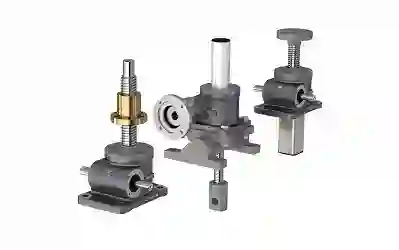Lifting screw jacks are workhorses in industrial applications, renowned for their power and precision. However, stability is paramount when dealing with heavy loads. Here’s how to optimize screw jack stability and ensure safe, efficient lifting operations:
Foundation Matters:
- Solid and Level Base: The foundation upon which the screw jack rests is the cornerstone of stability. Choose a flat, level surface capable of withstanding the load exerted by the jack and the lifted object. Uneven surfaces can cause the jack to tilt, compromising safety and potentially damaging the jack itself.
- Anchoring the Jack (When Applicable): For specific applications, particularly those involving significant loads or uneven lifting surfaces, consider anchoring the screw jack’s base plate to the foundation. This provides additional stability and prevents the jack from shifting during operation.
Optimizing the Screw Jack Selection:
- Matching Capacity to Load: Select a screw jack with a load capacity exceeding the weight you intend to lift. Overloading a jack is a recipe for instability and potential failure. Refer to the manufacturer’s specifications for the recommended load capacity of your chosen model.
- Base Plate Size: For applications requiring enhanced stability, consider screw jacks with larger base plates. A wider base provides a more substantial footprint, distributing the load over a greater area and reducing the risk of tipping.
Additional Considerations for Enhanced Stability:
- Multiple Jacks for Heavy Loads: When dealing with exceptionally heavy loads, consider using multiple synchronized screw jacks. Distributing the lifting force across multiple jacks significantly improves stability compared to relying on a single jack.
- Lifting Slings and Center of Gravity: Employ properly rated lifting slings to distribute the load evenly when lifting objects. Ensure the center of gravity of the lifted object is centered above the screw jack to prevent unbalanced forces that could cause tipping.
- Jack Alignment: When using multiple jacks, ensure they are perfectly aligned vertically. Misalignment can introduce uneven forces and compromise stability.
Advanced Techniques for Specific Scenarios:
- Inclined Lifting: For situations requiring lifting at an angle, specialized screw jacks with tilting bases or additional support structures might be necessary to maintain stability. Consult with a qualified engineer to determine the safest and most appropriate approach for inclined lifting scenarios.
- Uneven Surfaces: For lifting on uneven surfaces, leveling pads or wedges can be used to create a stable base for the screw jack. Always ensure the jack itself remains upright and properly aligned.
Conclusion:
By prioritizing a solid foundation, selecting the right screw jack for the load, and implementing additional stability measures, you can transform your lifting jack screws from powerful tools into dependable pillars of safety and efficiency. Remember, stability is paramount when dealing with heavy loads, and taking these precautions will ensure successful and secure lifting operations.









